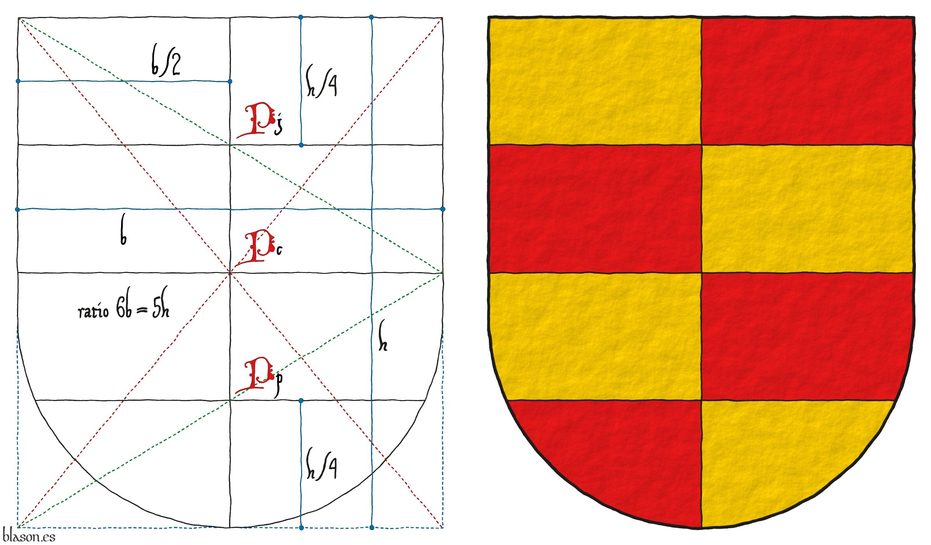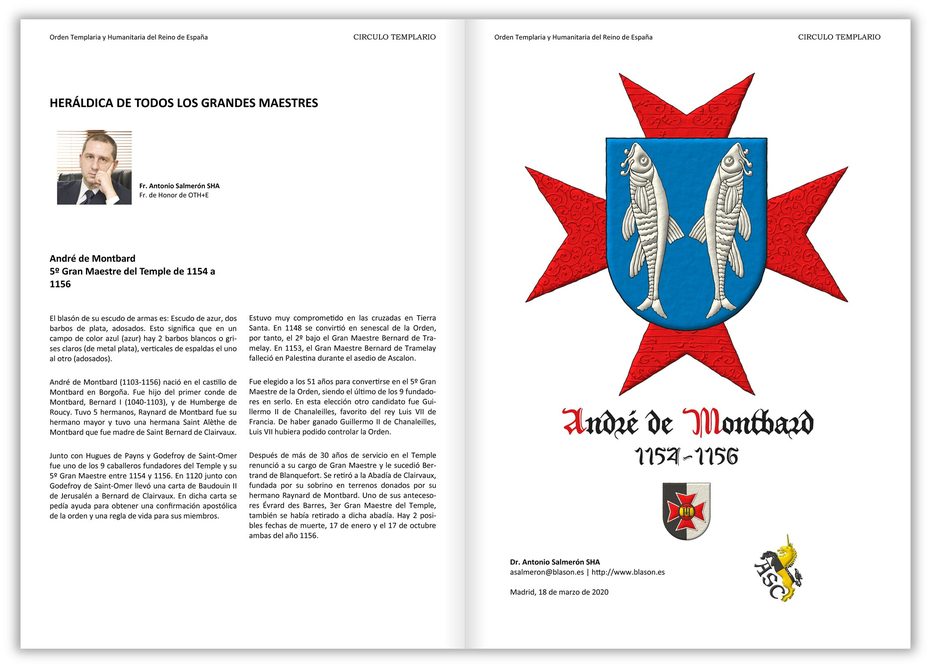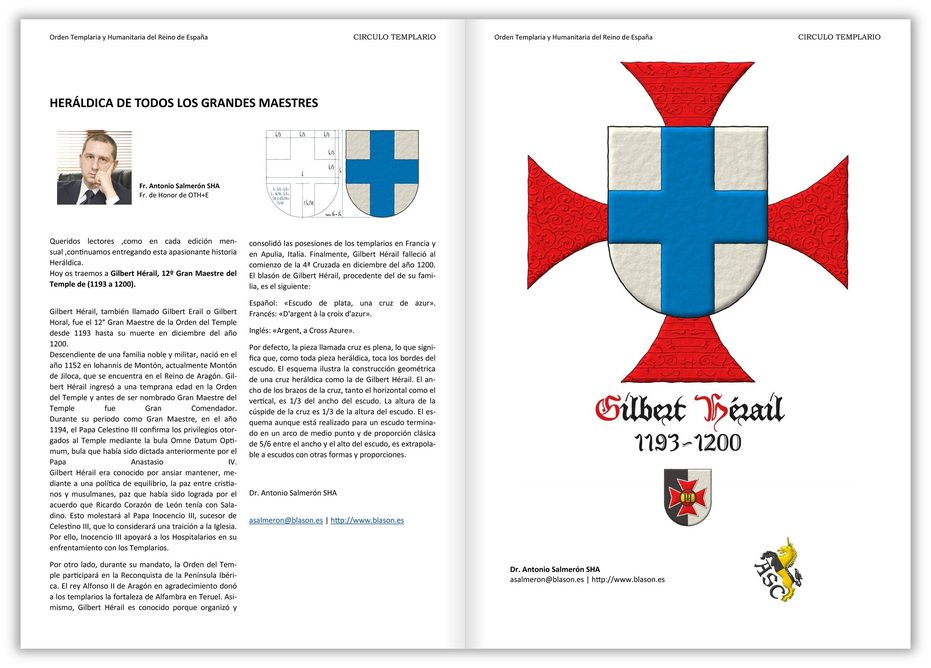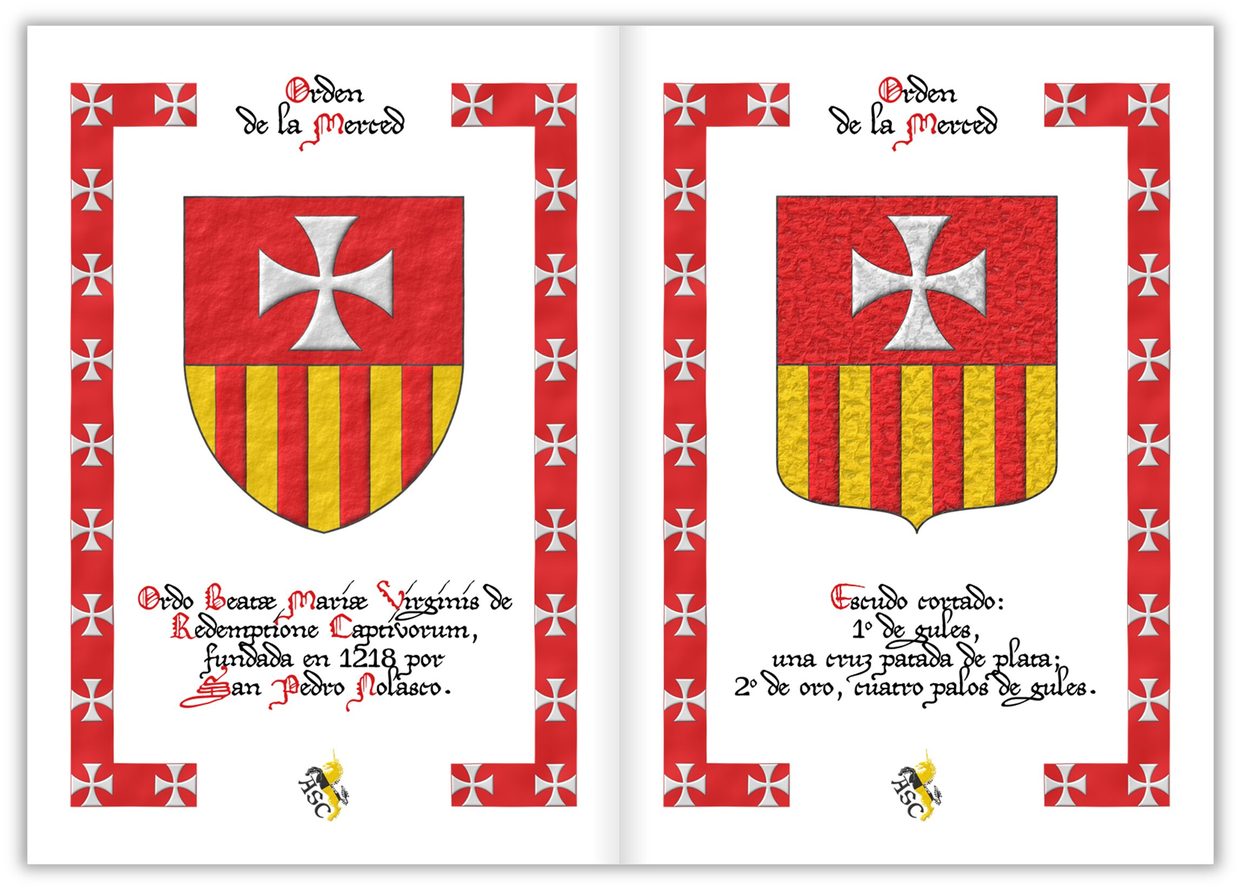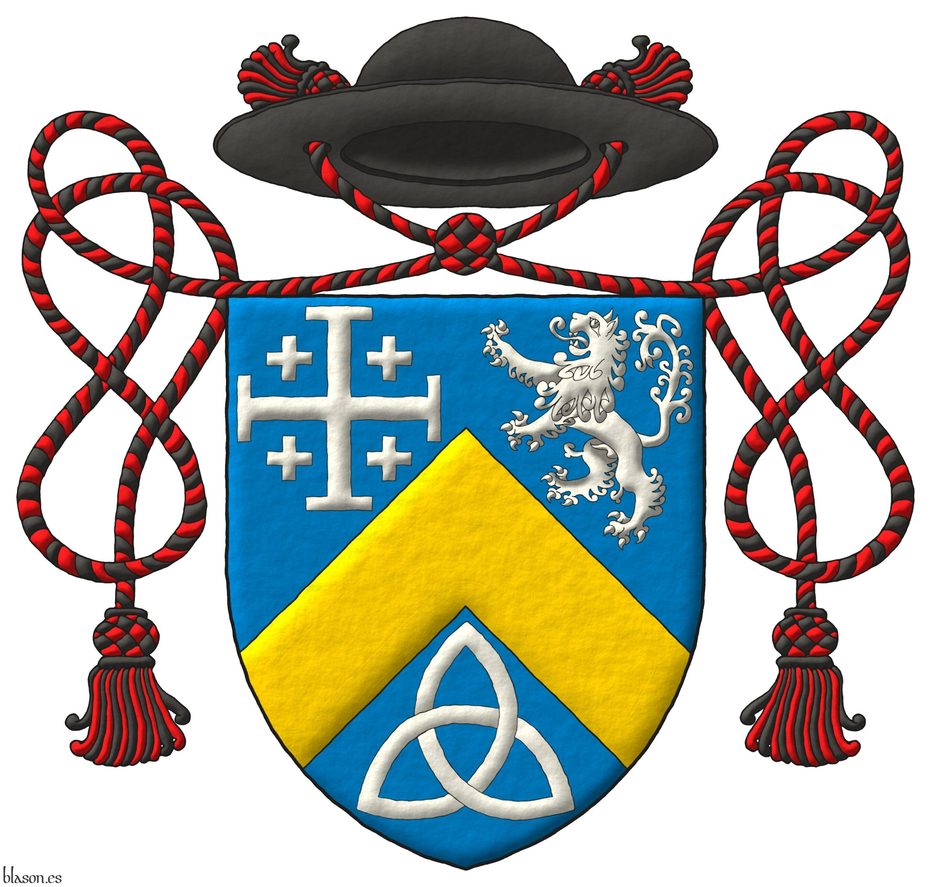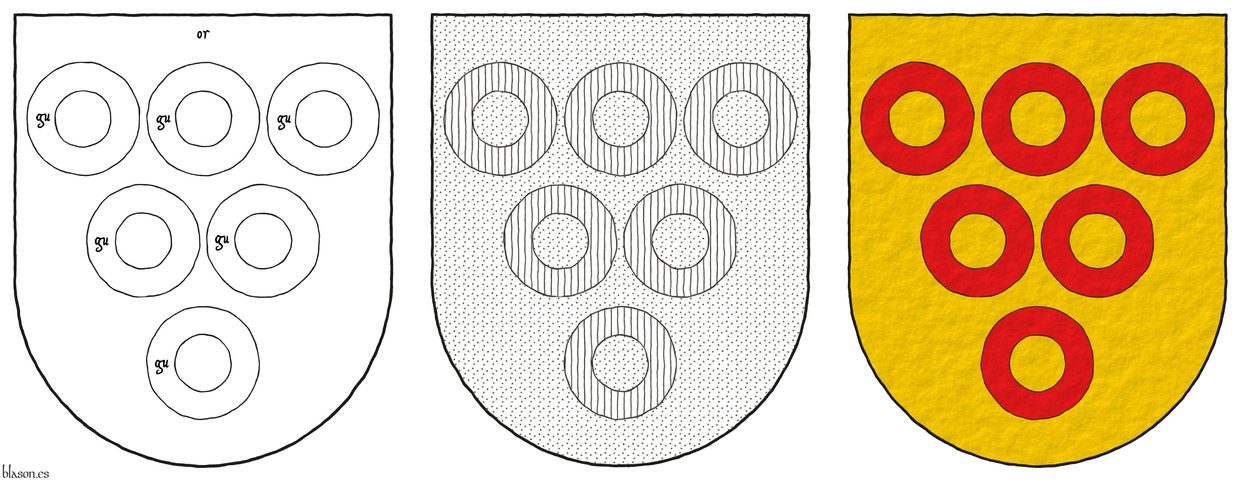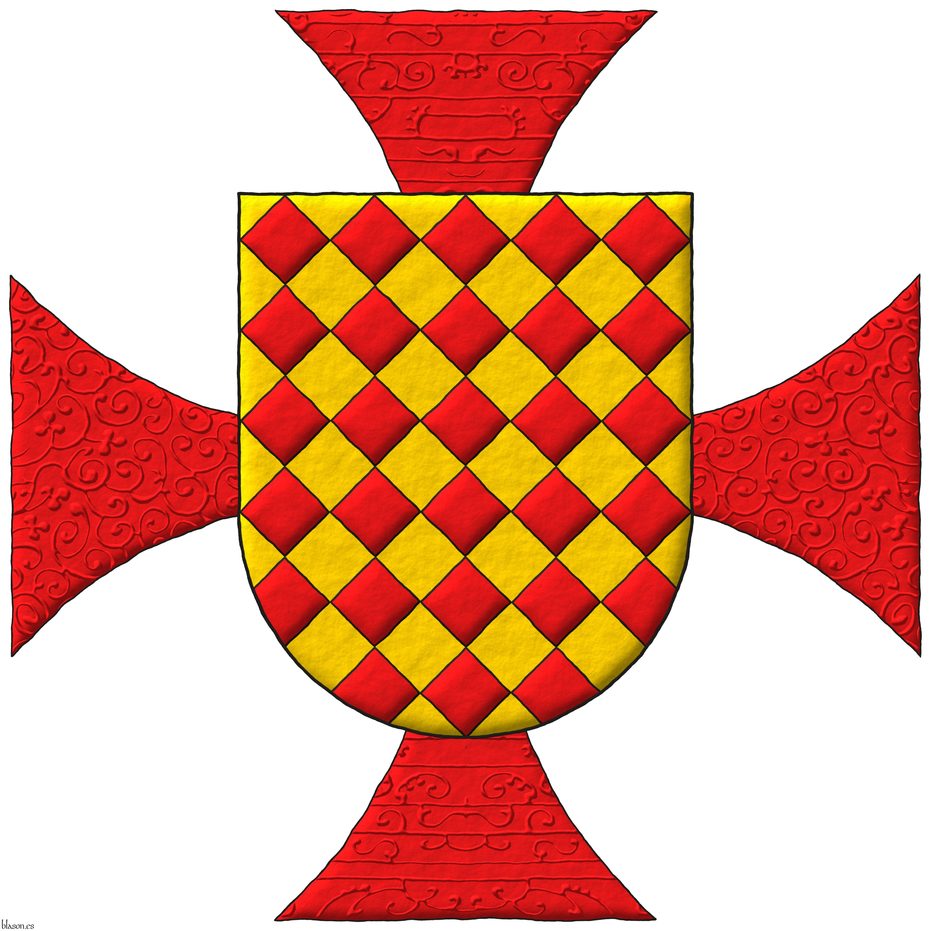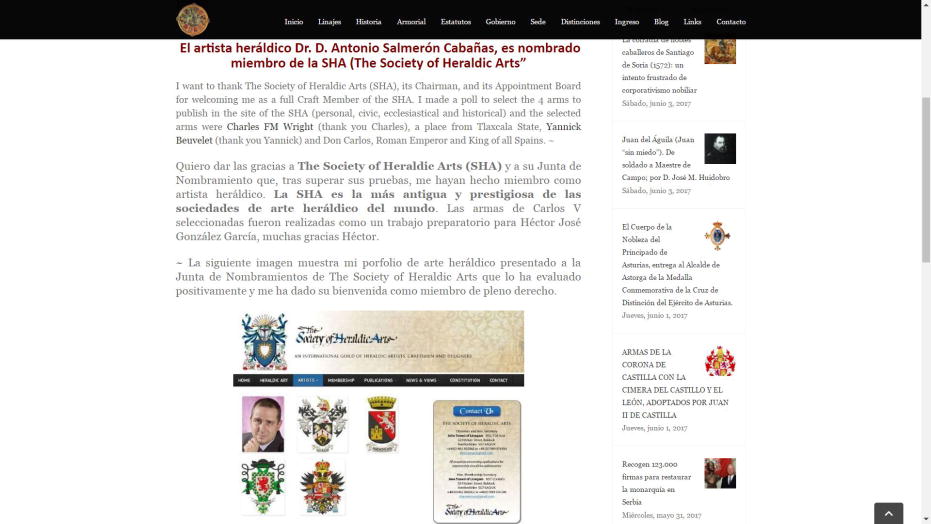Religious heraldry

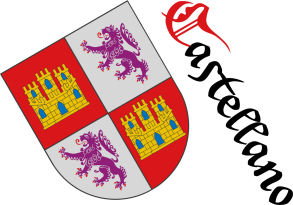
Adrian V
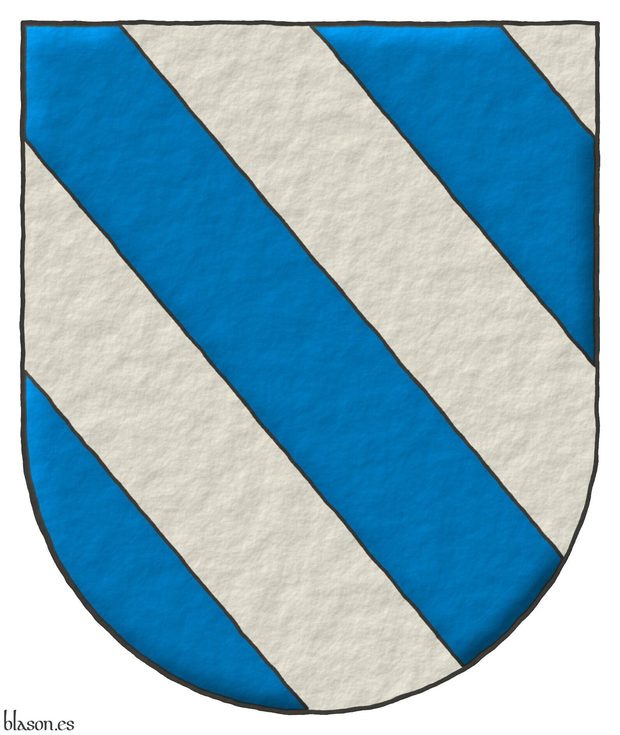
186th Pope of the Church, only 40 days in 1276. «Hadrianus V», born Ottobuono de Fieschi, was born in Genoa.
Bendy of six Azure and Argent.
Escudo bandado de seis piezas de azur y plata.
Papal coat of arms interpreted by me with: a shield with a rounded arch top; the field in plain tincture of Argent; the bands illuminated in Azure and outlined in Sable; and the whole in an elevated line style.
The blazon in French is «Bandé d'azur et d'argent de six pièces».
The banding is defined in [Avilés, J.; 1725a; page 40] and [Avilés, J.; 1780a; page 45] as the shields and also, the chiefs, fesses, pales, and figures, such as animals, etc., that are «covered and filled with bands in equal number, with as many of metal as of color».
Blazon keywords: Without divisions, Bendy, Six, Azure and Argent.
Style keywords: Semi-circular, Illuminated, Outlined in sable and Freehand.
Classification: Interpreted, Religious and Papal States.
Bearer: Adrian V.


Benedict XII
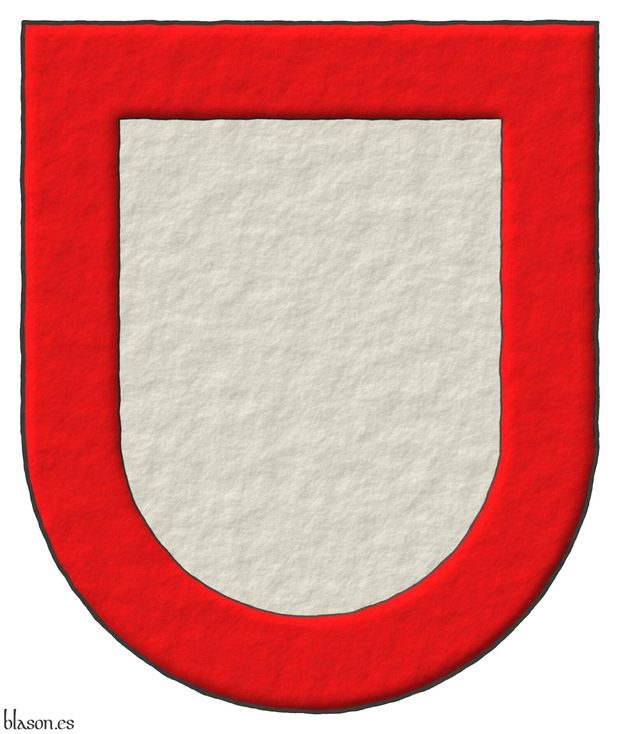
197th Pope of the Church, from 1334 to 1342. «Benedictus XII», born Jacques Fournier, was born in Saverdun, in the south of Occitania.
Argent, a bordure Gules.
Escudo de plata, una bordura de gules.
Papal coat of arms interpreted with: a round-topped shield; the field in plain Argent; the bordure outlined in Sable and illuminated in Gules; and the whole design in raised outline.
Blazon keywords: Without divisions, Argent, One, Bordure and Gules.
Style keywords: Semi-circular, Illuminated, Outlined in sable and Freehand.
Classification: Interpreted, Religious and Papal States.
Bearer: Benedict XII.


Benedict XIV
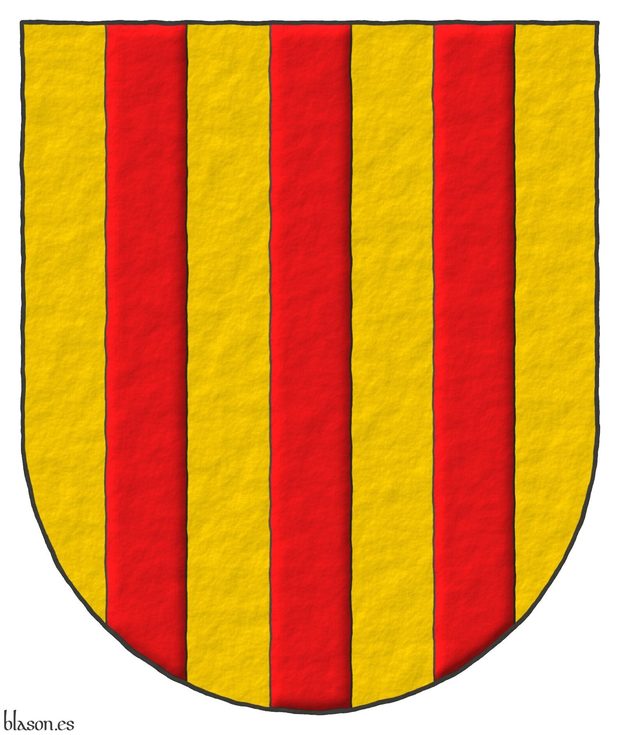
247th Pope of the Church, from 1740 to 1758. «Benedictus XIV», named Prospero Lorenzo Lambertini, born in Bologna.
Or, three pallets Gules.
Escudo de oro, tres palos de gules.
Papal coat of arms interpreted with: a rounded mouth; the field in flat tincture of Or; the pales outlined in Sable and illuminated in Gules enamel; and the whole with a raised stroke finish.
Blazon keywords: Without divisions, Or, Three, Pale and Gules.
Style keywords: Semi-circular, Illuminated, Outlined in sable and Freehand.
Classification: Interpreted, Religious and Papal States.
Bearer: Benedict XIV.


Bertrand de Blanchefort two-step scheme
Barry of four per pale counterchanged Or and Gules.
Blazon keywords: Barry per pale counterchanged, Four, Or and Gules.
Style keywords: Outlined in sable, Semi-circular, Ratio and Plain tincture.
Classification: Religious, Military, Knights Templar, Interpreted, Coat of arms and Schema.
Bearer: Blanchefort, Bertrand de.


![Ver [Calatrava, Order of] en instituciones citadas. Fortaleza de oro y mazonada de sable.](../css/Fortaleza.Institucion.png)
Calatrava, Order of
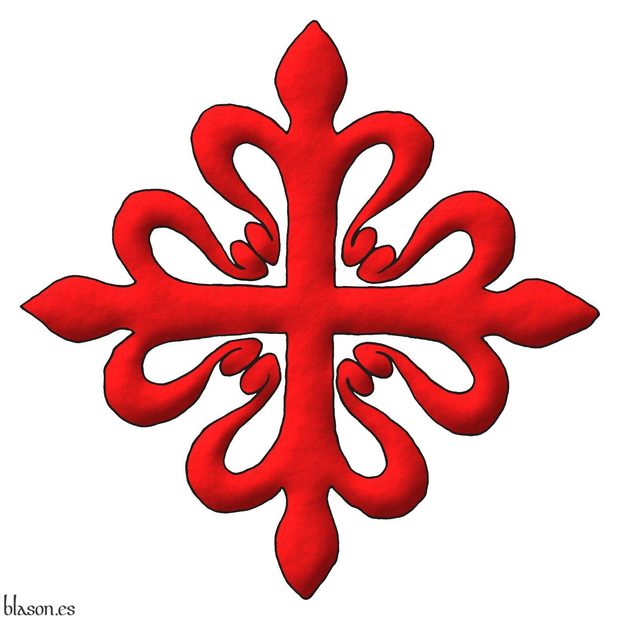
The Order of Chivalry of Calatrava is both military and religious, founded in the Kingdom of Castile during the 12th century by Abbot Raymond of Fitero.
The purpose of its foundation was the protection of the town of Calatrava la Vieja, which currently belongs to the municipality of Carrión de Calatrava in Ciudad Real. At the time of the order's foundation, it was an important city, in the middle valley of the river Guadiana and with a strategic position, as it was a necessary passage on the road from Toledo to Córdoba to Toledo and between the west and east of the Iberian Peninsula.
On the origin and antiquity of the Military Order of Calatrava, and the form of its Commandery
[Avilés, J.; 1780b; treatise IV, chapter IV, pages 334] writes «The Military Order of Calatrava was instituted by Don Sancho III, King of Castile (called the Desired), in the year 1158, while he was visiting his Kingdom; and being in Toledo with news of the great army that the Moors were gathering to besiege Calatrava la Vieja (which is called so today to distinguish it from the new one, which was founded later); and as the Templars, to whom this Fortress belonged, did not have sufficient power to resist such a large multitude, they handed it over to King Don Sancho himself so that he could take charge of it, as he did».
[Avilés, J.; 1780b; treatise IV, chapter IV, page 335] continues by telling us «The Abbot of Santa María de Fitero», near the river Pisuerga as he will indicate next, «of the Congregation of Cistercian, in the Bishopric of Palencia (which is a Monastery of St. Bernard, located on the river Pisuerga), named Don Raymond, and Friar Diego Velazquez, his subject Monk, who followed the Court, despite the difficulty of the enterprise, requested it from the King to defend it, which was granted, trusting in the virtue of the Abbot, and the strength of the Monk, who had previously been a great Knight in deeds of Arms, and very practiced in war».
[Avilés, J.; 1780b; treatise IV, chapter IV, page 336] continues «Seeing themselves in such an obligation, and that by themselves they could not fulfill it, they turned to Archbishop Don Juan (who was the fourth of Toledo) for help; and he, granting many indulgences in all his Archbishopric to those who, for themselves and for others, supplied the Place with provisions, in the same way as those who, unable to go due to old age or illness, helped with weapons, horses, and men; and having spread this news, so much help came to them, that when the Moors learned that the number of people exceeded twenty thousand men, they abandoned the conquest, returning to their homes: for this reason, the King ceded the Town of Calatrava to the Abbot of Fitero, and his successors, to defend it from the Moors from then on, confirmed later by King Alfonso IX, his son».
[Avilés, J.; 1780b; treatise IV, chapter IV, page 337] concludes «Having obtained this grace, Abbot Don Raymond brought the most suitable Monks from Fitero to Calatrava, and everything else that was necessary for living and for the defense of the Town and its land, which with the people inclined to war who remained, formed the Order of Chivalry of Calatrava, taking this name from the place where the institution was made, which in Arabic Calatrava means Castle».
Categories: Institution, Interpreted, Religious, Military, Illuminated, Outlined in sable, Freehand, Emblem, Cross of Calatrava, Cross couped and Cross.


Clement V
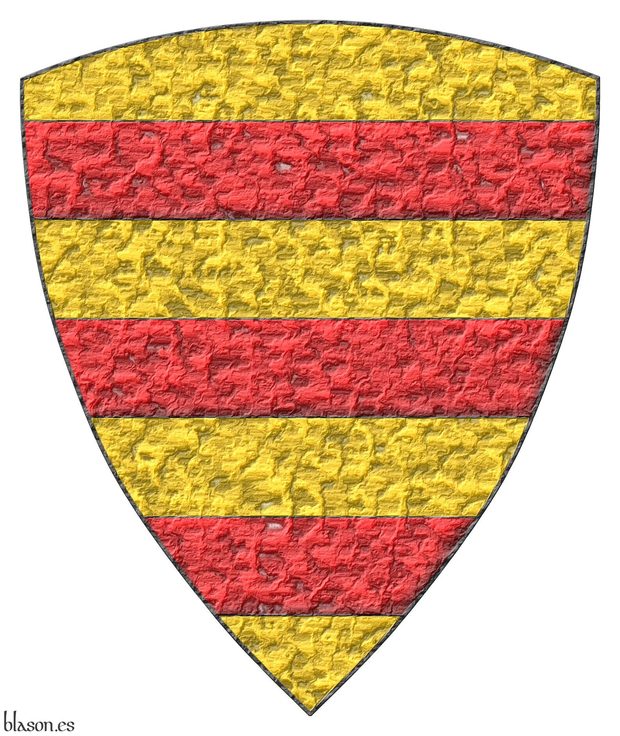
195th Pope of the Church, from 1305 to 1314. «Clemens V», born Bertrand de Got, born in Villandraut, in the southwest of France, was the first pope to reside in Avignon in a stable manner.
Or, three fesses Gules.
Escudo de oro, tres fajas de gules.
Papal coat of arms interpreted with: a rounded triangular top; the field in plain Or enamel; the bars illuminated in Gules and outlined in Sable; and with a heavily hammered metal finish.
Blazon keywords: Without divisions, Or, Three, Fess and Gules.
Style keywords: Triangular curved, Illuminated, Outlined in sable and Hard metal.
Classification: Interpreted, Religious and Papal States.
Bearer: Clement V.
Blazon equivalent to: Fernández de Córdoba y Carrillo, Diego.


Clement XII
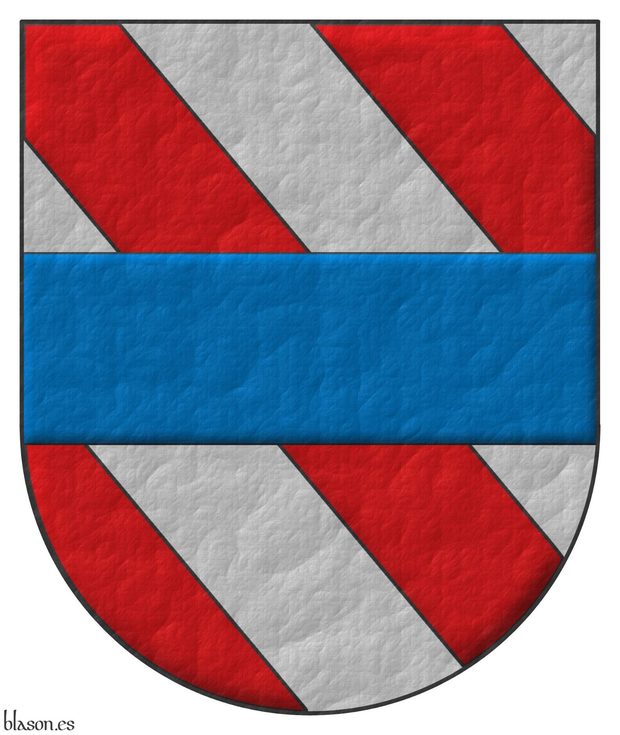
246th Pope of the Church, from 1730 to 1740. «Clemens XII», named Lorenzo Corsini, born in Florence and rests in St. John Lateran.
Bendy of six Gules and Argent; over all a fess Azure.
Escudo bandado de seis piezas de gules y plata; brochante sobre el todo una faja de azur.
Papal coat of arms interpreted with: a rounded mouth; the field in flat tincture of Argent; the fess and the bands outlined in Sable and illuminated in Gules and Azure; and the whole with a textured finish.
All are ordinaries, including the three bands and the fess, and since the blazon specifies that the fess is overall on the bands, therefore, it is not the Gules bands that are overall on the Azure fess, and they should be painted underneath.
Blazon keywords: Without divisions, Bendy, Six, Gules, Argent, Surmounted, Overall (deprecated), One, Fess and Azure.
Style keywords: Semi-circular, Illuminated, Outlined in sable and Freehand.
Classification: Interpreted, Religious and Papal States.
Bearer: Clement XII.


Eugene IV
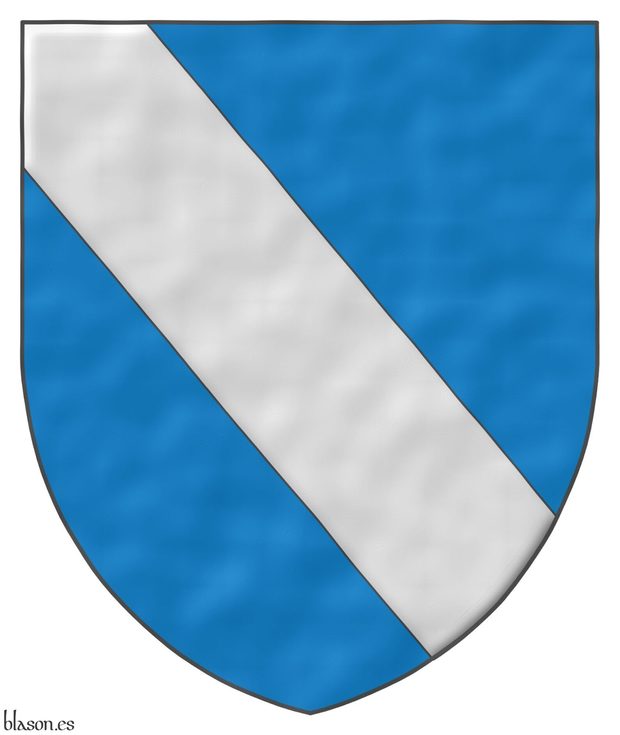
Papa número 207 de la Iglesia, de 1431 a 1447. «Eugenius IV», de nombre Gabriele Condulmer, nació en Venecia.
Azure, a bend Argent.
Escudo de azur, una banda de plata.
Escudo papal que he interpretado con: la boca apuntada; el campo de tinta plana de azur; la banda iluminada de azur y delineada de sable; y el conjunto acuarelado.
Blazon keywords: Without divisions, Azure, One, Bend and Argent.
Style keywords: Pointed, Illuminated, Outlined in sable and Watercolor.
Classification: Interpreted, Religious and Papal States.
Bearer: Eugene IV.


Gregory X
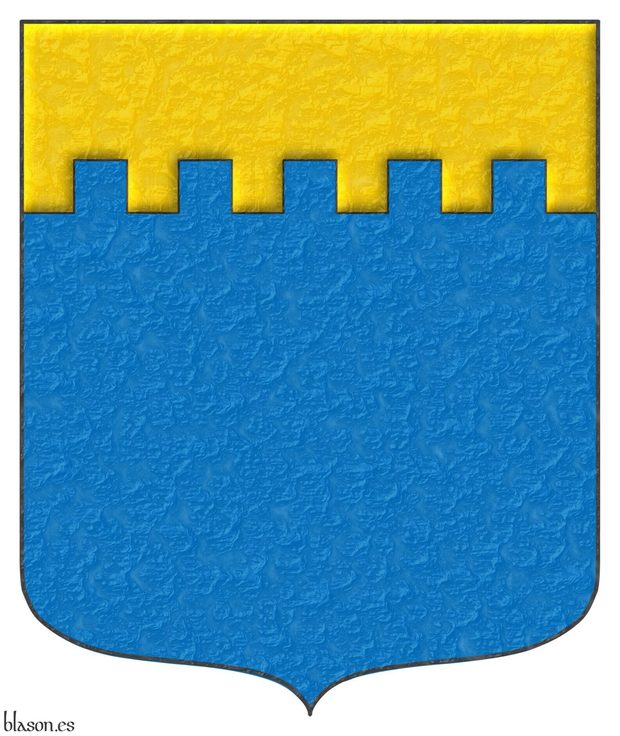
184th Pope of the Church, from 1271 to 1276. «Gregorius X», born Teobaldo Visconti, was born in Piacenza and convened the 14th Ecumenical Council, known as the Second Council of Lyon.
Azure, a chief embattled Or.
Escudo de azur, el jefe almenado de oro.
Papal coat of arms interpreted by me with: a pointed and rounded shield shape; the field in plain Azure; the chief embattled, illuminated in metal Or and outlined in Sable; and the whole with a marbled finish.
My first version of the blazon in English was «Azure, a chief Or, embattled», but Michael McCartney suggested that it was more correct as «Azure, a chief embattled Or».
Blazon keywords: Without divisions, Azure, Chief, Or and Embattled.
Style keywords: Ogee, Illuminated, Outlined in sable and Marmoreal.
Classification: Interpreted, Religious and Papal States.
Bearer: Gregory X.


Holy Trinity
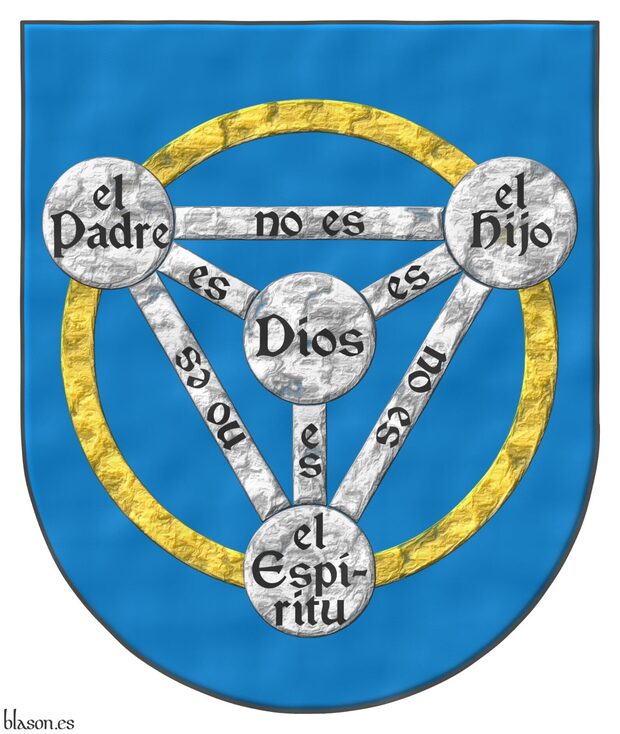
Azure, a pall couped Argent, its three arms charged with «es» Sable, within a triangle reversed Argent, its three arms charged with «no es» Sable, within an annulet Or, all debruised by four plates, three on the vertex of the triangle, in dexter chief, charged with «el Padre» Sable, in sinister chief, charged with «el Hijo» Sable, in base, charged with «el Espítiru» Sable, and one on the fess point, charged with «Dios» Sable.
Escudo de azur, una perla recortada de plata, sus tres brazos cargados con «es» de sable, dentro de un triángulo ranversado de plata, sus tres brazos cargados con «no es» de sable, dentro de un anillo de oro, todo resaltado de cuatro bezantes de plata, tres sobre los vértices del triángulo, en la diestra del jefe, cargado de «el Padre» de sable, en la siniestra del jefe, cargado con «el Hijo» de sable, en la punta, cargado con «el Espítiru» de sable y uno sobre el corazón, cargado con «Dios» de sable.
Imaginary coat of arms that I have interpreted as follows: its base is semicircular (round); its field is illuminated in watercolor Azure; the rest in heavily beaten metal, outlined of the field and illuminated in Argent, except for the annulet which is illuminated in Or; and its letters all in plain Gules ink.
Annulet
The circular crown when it is large and in the middle of the shield [Cadenas y Vicent, V. de; 1975] is called an annulet. [Avilés, J.; 1780a; pages 296 and 297] calls it annulet or small annulet depending on its size, if it is large an annulet and if it is small a small annulet. In English and French heraldry it is called «cyclamor» and hence the expression «cyclamor annulet» can also be found.
This annulet is my aesthetic contribution to this imaginary coat of arms as it is normally not represented with this annulet.
Bordure and Orle
In other interpretations the words «non est» go on a bordure or on an orle, the latter being the case blazoned, for example, [Husenbeth, F. C.; 1882; 2nd appendix] in the following way: «Gules, an orle and pall Argent, conjoined and surmounted of four plates, occupying the dexter and sinister chief and the base and fess points respectively; the first inscribed Pater, the second Filius, and the third Spiritus Sanctus, the centre Deus; the connecting portions of the orle between them having the words non est, and those of the pall est».
Blazon keywords: Without divisions, Azure, Cyclamor, Pall, Closed, Argent, Charged, Bezant and plate, Or, Dexter, Sinister, Chief, Base (lower 1/3) and Heart.
Style keywords: Semi-circular, Illuminated, Outlined in the field tincture, Watercolor and Hard metal.
Classification: Religious, Interpreted, Imaginary and Coat of arms.
Imaginary bearer: Holy Trinity.


![Ver [Husenbeth, F. C.; 1882] en referencias bibliográficas. Libro abierto, hojas de plata, filo de oro, guardas de gules, tapas de sable.](../css/Libro.Bibliografia.png)
Husenbeth, F. C.; 1882
Frederick Charles Husenbeth, «Emblems of saints: by which they are distinguished in works of art», with 2 appendices «On the treatment of the Sibyls in art» by William Marsh and «On sacred heraldry» by Edward Lushington Blackburne, 3th edition edited by Augustus Jessopp, printed by A. H. Goose and Co. for the Norfolk and Norwich Archaeological Society, Norwich, 1882.
Bibliographical reference of century XIX.
The author is Husenbeth, Frederick Charles.
Bibliographical reference mentioned in the following article:
External links:


Innocent IV

180th Pope of the Church, from 1243 to 1254. «Innocentius IV», born Sinibaldo dei Fieschi, was born in Manarola in northwest Italy.
Bendy of six Azure and Argent.
Escudo bandado de seis piezas de azur y plata.
Papal coat of arms interpreted by me with: a semicircular shield shape; a plain Argent field; bands illuminated in Azure and outlined in Sable; and the whole design with a watercolor finish.
Order of tinctures
In the bendy pattern, the tinctures are named starting from the one located at the dexter base of the shield and following an ascending sequence towards the sinister chief, although the most orthodox approach is to have only 2 tinctures, being one color and one metal.
Number of bands
It is said that it is not necessary to specify the number of bands when there are precisely 6, as in this case, and that it should be specified when there are, for example, 4 or 8. I have chosen to specify it for greater clarity of the blazon.
About the bendy pattern and the need to specify or not specify the number of its pieces, [Avilés, J.; 1725a; pages 40 and 41] and [Avilés, J.; 1780a; pages 45 and 46] say that it is «composed of four, six, or eight bends; in such a way that there are as many colors as metals, always specifying the number four and eight bands when blazoning, and not the one composed of six, as it is understood thus, without declaring the number of pieces» and without agreeing with it, and by its wording I believe that he is not entirely in agreement either, he adds «the reason that may exist for not specifying the number of six bends (although the authors do not express it) is that as the bend is one-third of the shield; and having six pieces, or six bends, the resulting number is doubled, as if the three parts were divided, which implies that the shield is filled with three bends; and taking the denomination of the figure infers, that the bendy is of six pieces: which does not happen with this equality in those of four and eight, requiring other proportions and consequently it becomes necessary to specify their number», therefore, note that the bendy of 6 does not follow the proportions of the bend, nor do those of 4 or 8, the only differential property of the one of 6 is being a multiple of 3, being 1/3 the width of the bend.
Blazon keywords: Without divisions, Bendy, Six, Azure and Argent.
Style keywords: Semi-circular, Illuminated, Outlined in sable and Watercolor.
Classification: Interpreted, Religious and Papal States.
Bearer: Innocent IV.


Jesus Christ, with bezants Or
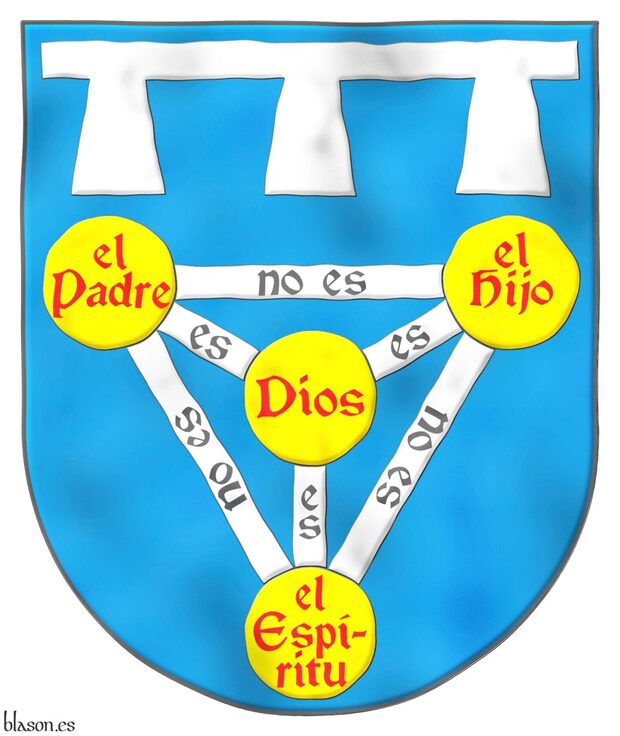
Azure, a pall couped Argent, its three arms charged with «es» Sable, within a triangle reversed Argent, its three arms charged with «no es» Sable, all debruised by four bezants, three on the vertex of the triangle, in dexter chief, charged with «el Padre», in sinister chief, charged with «el Hijo», in base, charged with «el Espítiru», and one on the fess point, charged with «Dios» Gules; in chief a label of three points Argent.
Escudo de azur, una perla recortada de plata, sus tres brazos cargados con «es» de sable, dentro de un triángulo ranversado de plata, sus tres brazos cargados con «no es» de sable, todo resaltado de cuatro bezantes de oro, tres sobre los vértices del triángulo, en la diestra del jefe, cargado de «el Padre», en la siniestra del jefe, cargado con «el Hijo», en la punta, cargado con «el Espítiru» y uno sobre el corazón, cargado con «Dios» todo de gules; en jefe un lambel de tres pendientes de plata.
Imaginary coat of arms that I have interpreted as follows: its base is semicircular (round); its field is illuminated in Azure; the rest is illuminated in Argent and outlined in Sable, except for the bezants which are Or and also outlined in Sable; its letters in plain tinctures, some Gules and others Sable; and the set with a glazed finish.
Pall
The pall (perla) as defined by [Avilés, J.; 1780a; page 239] is «a figure composed of three moving cotises, or that emerge from the two angles of the Chief and the Base, which meet in the center or heart of the Shield in the form of a Greek Y, as if this figure were formed from a half Saltire, and a half Pale».
Blazon keywords: Without divisions, Azure, One, Pall, Couped, Argent, Three, Charged, Letter, Sable, Within, Triangle, Reversed, Four, Bezant, In the dexter chief, In the sinister chief, In base, In the fess point, Gules, Cadency and Label of three points.
Style keywords: Semi-circular, Illuminated, Outlined in sable and Glass.
Classification: Religious, Interpreted, Imaginary and Coat of arms.
Imaginary bearer: Jesus Christ.


John XXI
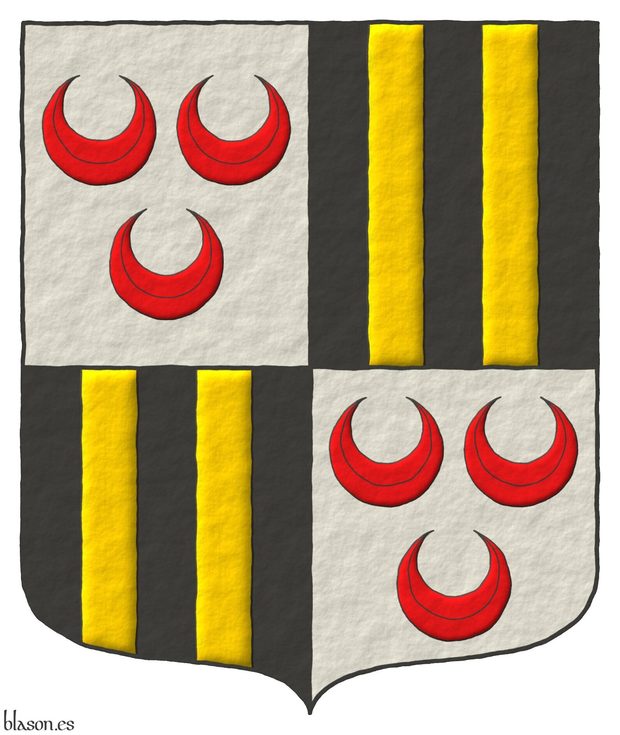
187th Pope of the Church, from 1276 to 1277. «Johannes XXI», born Pedro Julião, also known as Pedro Hispano, born in Lisbon, Portugal.
Quarterly: 1 and 4 Argent, three crescents Gules; 2 and 3 Sable, two pallets Or.
Escudo cuartelado: 1o y 4o de plata, tres crecientes de gules; 2o y 3o de sable, dos palos de oro.
Coat of arms with: a shield with a pointed and rounded top; the field in plain Argent and Sable; the figures outlined in Sable and illuminated in Gules and Or; and the whole in an elevated line style.
John XXI should have actually been John XX, but Cardinal Pedro Julião, upon being elected pope, decided to skip the number XX and called himself John XXI, with the aim of correcting what was believed to be a historical error, which in the end was not so.
This historical error consisted of the belief in the existence of 2 popes named John XIV, as seemed to be deduced from the records of the «Liber Pontificalis». They were therefore referred to as: the 1st John XIV and the 2nd John XIV bis.
By skipping the number XX, John XXI believed he was correcting this historical error. But the reality is that there was only one Pope John XIV, the same pope with 2 entries in the «Liber Pontificalis», the 1st entry during the time of his pontificate in freedom and the 2nd entry for the time he exercised his pontificate in prison, imprisoned by his enemy, the so-called «antipope» Boniface VII, who, in turn, managed to occupy the papal throne twice, separated by a decade, in 974 and in 984, somewhat like a double «antipope».
Therefore, John XXI, instead of correcting a historical error, made one, and for this reason, there is no Pope John XX in all of history, nor can there ever be one.
Blazon keywords: Quarterly, Argent, Three, Crescent, Gules, Ordered, Sable, Two, Pale and Or.
Style keywords: Ogee, Illuminated, Outlined in sable and Freehand.
Classification: Interpreted, Religious and Papal States.
Bearer: John XXI.


Knights Templar, Grand Master number 05
Azure, two barbels addorsed Argent. Behind the shield an eight-pointed cross patty Gules.
I have had the honour of writing this article about André de Montbard and its coat of arms within a series of 23 articles about the heraldry of the Grand Masters of the Temple.Classification: Religious, Military, Knights Templar, Interpreted, Doctor, Article, Castilian language and Black and white and color illustrations.
Bearer: Montbard, André de.


Knights Templar, Grand Master number 12
Argent, a cross Azure. Behind the shield a cross patty Gules.
Classification: Religious, Military, Knights Templar, Interpreted, Doctor, Article, Castilian language and Black and white and color illustrations.
Bearer: Hérail, Gilbert.


Lucius III
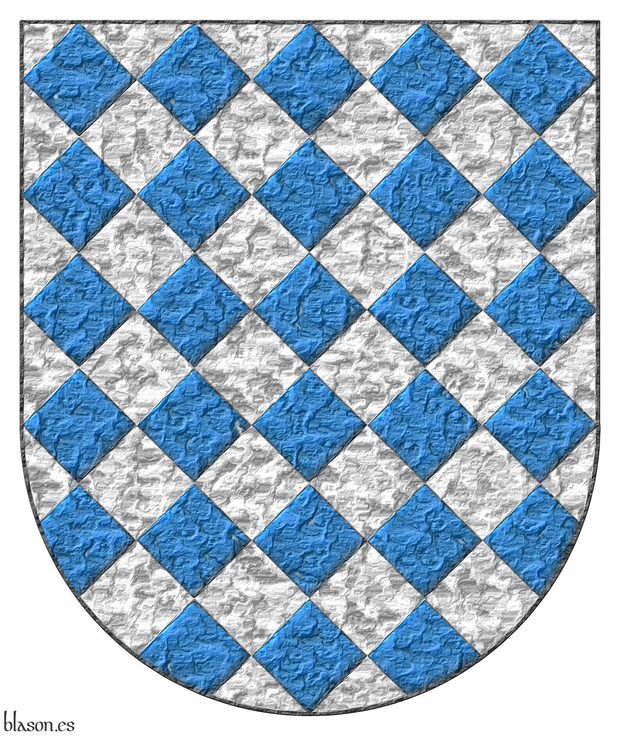
171st Pope of the Church, from the year 1181 to the year 1185. «Lucius III», born Ubaldo Allucinoli, was born in Lucca in northwest Italy.
Lozengy Argent and Azure.
Escudo losanjado de plata y azur.
Papal coat of arms interpreted by me with: a semicircular shield shape; a plain Argent field; checky or squares illuminated in Azure and outlined in Sable; and the whole design with a watercolor finish.
Blazon keywords: Without divisions, Lozengy, Argent and Azure.
Style keywords: Semi-circular, Illuminated, Outlined in sable and Hard metal.
Classification: Interpreted, Religious and Papal States.
Bearer: Lucius III.


Marc Eschenlauer
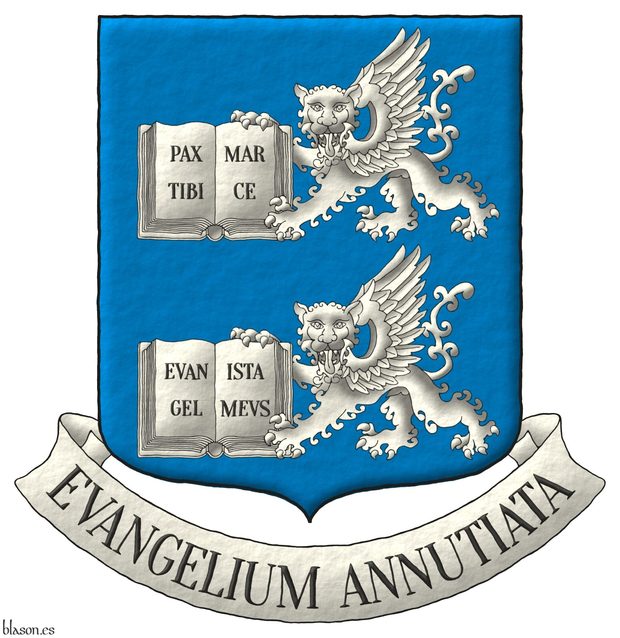
Azure, two lions passant, guardant, winged, each holding in its paws an open book Argent, with the inscription «Pax Tibi Marce Evangelista Meus» Sable distributed on their four pages. Motto: «Evangelium Annutiata».
Escudo de azur, dos leopardos alados, teniendo cada uno en sus garras un libro abierto todo de plata, con la inscripción «Pax Tibi Marce Evangelista Meus» de sable distribuida en sus cuatro páginas. Lema: «Evangelium Annutiata».
Coat of arms designed by me, illuminated with lights and shadows, contoured in Sable, with an ogee outer contour and with a freehand finishing.
Blazon keywords: Azure, Argent, Sable, Two, One, Four, Leopard, Winged, Grasping, Paw, Closed book, Book, Inscribed, Page and Motto.
Style keywords: Outlined in sable, Illuminated, Ogee and Freehand.
Classification: Religious, Created, Boa and Coat of arms.
Bearer: Eschenlauer, Marc.


Muscat, John
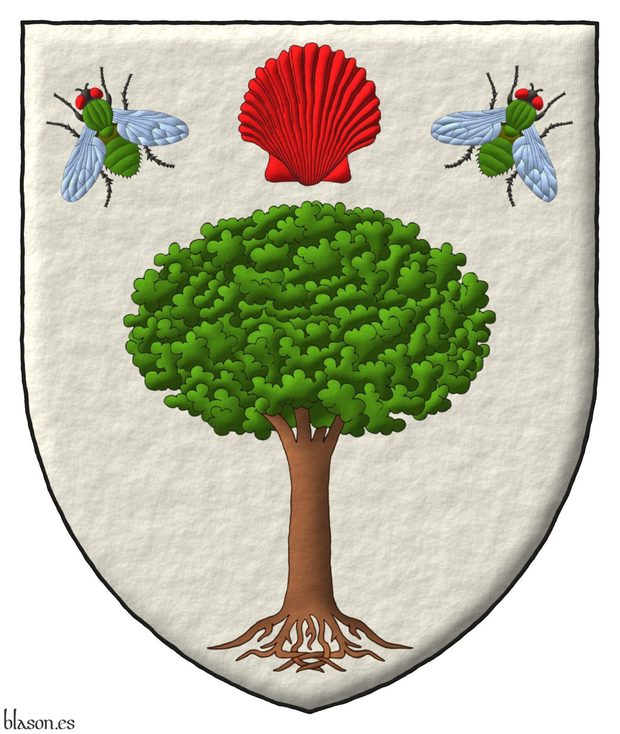
Argent, a tree eradicated proper, in chief an escallop reversed Gules, between two flies in pilewise proper.
Escudo de plata, un árbol arrancado al natural, en jefe una venera ranversada de gules acompañada de dos moscas puestas en pila al natural.
Arms painted by me, illuminated with lights and shadows, outlined in Sable, with a pointed external shape and with a freehand finish.
G0117, Chief Herald of Arms of Malta's grant of the coat of arms of the Reverend John Muscat, Honorary Monsignor of the Canon Chapter, Roman Catholic Cathedral of the Assumption, Gozo. This coat of arms has been emblazoned by me.
Blazon keywords: Argent, Gules, One, Two, Tree, Eradicated, Proper, In chief, Escallop, Between, Fly, Bendwise and Pilewise.
Style keywords: Outlined in sable, Illuminated, Pointed and Freehand.
Classification: Religious, Interpreted, Boa and Coat of arms.
Bearer: Muscat, John.


Oratorio de San Felipe Neri, coat of arms outlined
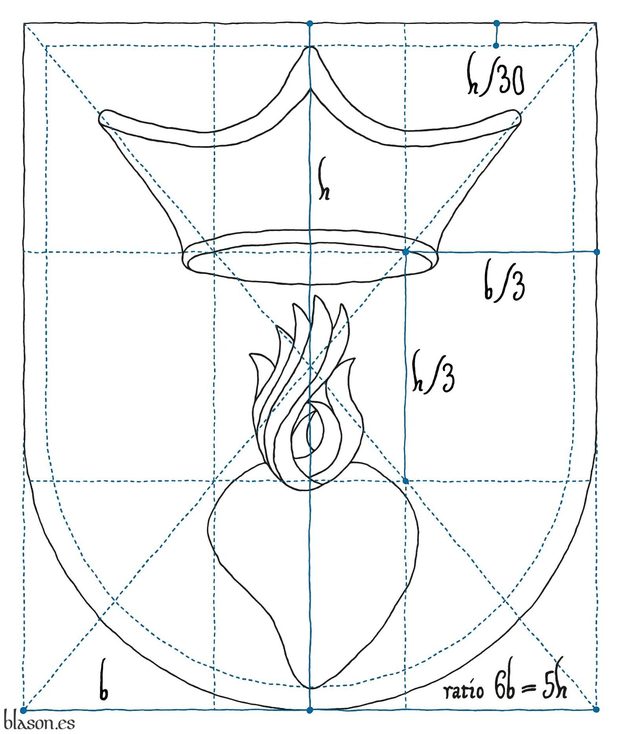
This coat of arms of the Congregacion del Oratorio de San Felipe Neri of Alcala de Henares, «Congregatio Oratorii Sancti Philippi Nerii - Complutum», has been designed, outlined, and emblazoned by me following the ideas and directions of the Congregation.
Blazon keywords: Argent, In chief, One, Ecclesiastical cap, Sable, In base, Heart enflamed, Heart, Enflamed and Gules.
Style keywords: Outlined in sable and Semi-circular.
Classification: Religious, Created and Coat of arms.
Bearer: Congregación del Oratorio de San Felipe Neri de Alcalá de Henares.


Order of Alcantara, emblem
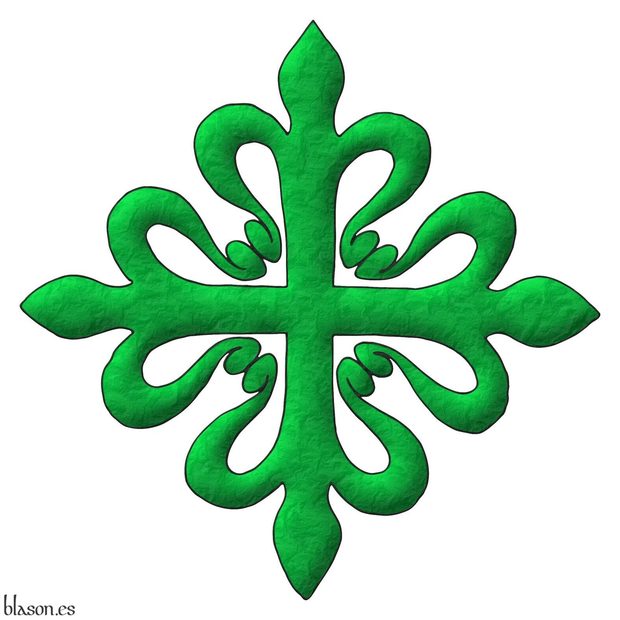
Order of Cavalry of Alcantara
A cross of Alcantara.
Una cruz de Alcántara.
Interpretation of the emblem of the order with: its cross outlined in Sable, illuminated in Vert; and a heavily beaten metal finish.
The Royal Council of the Orders of Chivalry of Santiago, Calatrava, Alcantara, and Montesa, in its historical account of the foundation of the Order of Alcantara, states that, according to Alonso de Torres y Tapia, Prior of Alcantara and a 17th-century chronicler, it was founded in 1156, by Don Suero Fernández Barrientos along with other knights from Salamanca, in Pereiro near the River Coa, under the name of the Order of Saint Julian of Pereiro and during the reign of Ferdinand II of León.
Emblem
Regarding the emblem of the Order of Cavalry of Alcantara, [Avilés, J.; 1780b; treatise IV, chapter V, page 340, figure 102], reusing the same figure 102 as for the Order of Calatrava, says «In the past, the Order of Alcantara displayed on its Standard the Gules Straps of Calatrava», remember that due to the commandery of the city of Alcantara, they had to assume some dependency on that of Calatrava, «next to a Pear tree in Vert on a field of Or, which was the insignia of the Order of Pereiro, due to the conformity with which these two Orders lived; but upon changing their Habit, the Pope» Eugene IV «granted them the green Cross», Vert, «in the manner they wear it today, differing from that of Calatrava only in color».
Blazon keywords: Cross of Alcantara, Cross couped and Cross.
Style keywords: Illuminated, Outlined in sable and Soft metal.
Classification: Interpreted, Religious, Military and Emblem.
Bearer: Alcantara, Order of.


Order of Mercy, decorative frame on 2 pages
Gules frame charged with 22 cross patties Argent; 11 crosses on each side; and written in Sable letters with Gules capital letters;
Blazon keywords: Party per fess, Gules, Or, Argent, Cross, One, Cross patty, Cross couped and Pale.
Classification: Interpreted, Religious and Frame.
Bearer: Our Lady of Mercy, Order of.


Order of Montesa, emblem
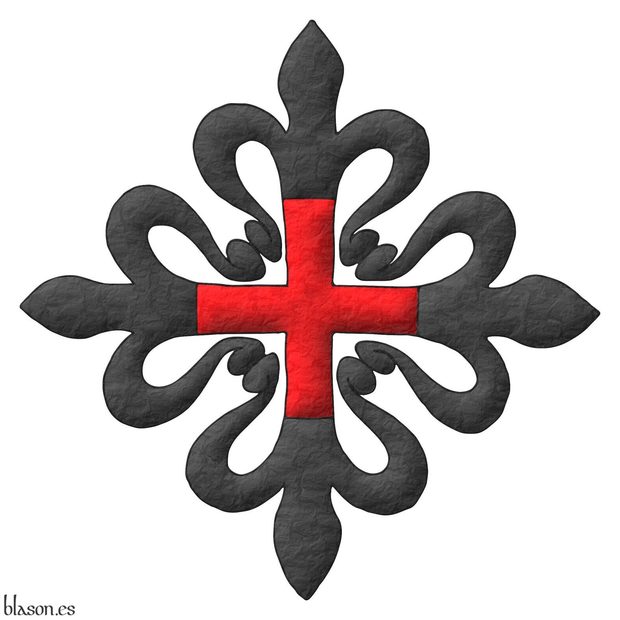
Order of Chivalry of Saint Mary of Montesa and Saint George of Alfama.
A cross of Montesa.
Una cruz de Montesa.
Interpretation of the emblem of the order with: its cross outlined in Sable, illuminated in Gules; and a highly hammered metal finish.
The Royal Council of the Orders of Chivalry of Santiago, Calatrava, Alcantara, and Montesa, in its historical review of the founding of the Order of Montesa, states that it was created in 1317, at the request of James II, King of Aragon, through a bull issued by Pope John XXII.
Emblem
About the emblem of the Order of Chivalry of Montesa [Avilés, J.; 1780b; treatise IV, chapter VI, page 342, figure 103], it states that «the Ensign of the Knights of Montesa is a plain red Cross», gules, «plain, which they wear on their Capitular Mantles, or hanging from a red ribbon on the chest over a gold oval; that is, on a field of gold a plain cross of gules (different from how the Masters wore it)» and, therefore, it describes the first emblem of the Order of Montesa and not the one they wear now, which is that same plain cross of gules charged on a cross like that of the Order of Calatrava or like that of the Order of Alcantara, but in Sable instead of Gules or Vert.
Blazon keywords: Cross of Montesa, Cross couped and Cross.
Style keywords: Illuminated, Outlined in sable and Soft metal.
Classification: Interpreted, Religious, Military and Emblem.
Bearer: Montesa, Order of.


Order of Santiago, emblem
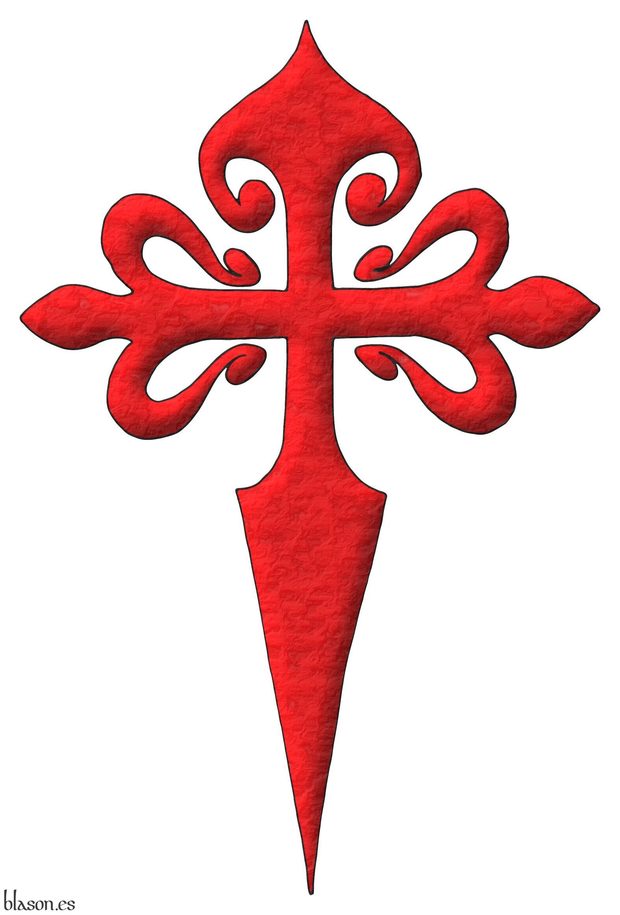
Order of Chivalry of Santiago
A cross of Saint James.
Una cruz de Santiago.
Interpretation of the emblem of the order with: its cross outlined in Sable, illuminated in Gules; and a heavily hammered metal finish.
The Royal Council of the Orders of Chivalry of Santiago, Calatrava, Alcantara, and Montesa, in its historical account of the foundation of the Order of Santiago, describes three different points of view:
- The one presented by tradition, which establishes it in 844, after the battle of Clavijo, when fourteen knights led by the Field Master Don Sancho Martínez de Tejada requested permission from Don Ramiro I, king of Asturias between the years 842 and 850, to found it. This traditional view is the one recorded in [Avilés, J.; 1780b; treatise IV, chapter II, page 325] when discussing the origin of the «Military Order of Santiago of the Sword».
- The perspective of historians like Claudio Sánchez Albornoz or Américo Castro, who question the earlier date. Furthermore, [Sánchez Albornoz, C.; 1965; pages 94-136], as cited in [Domínguez García, J.; 2008; pages 69-70], proposes that the actual battle of Clavijo occurred later, in the year 859, and that Ramiro I did not participate, but rather it was a conflict between King Ordoño I and the Moor Muza.
- The view of historians who, based on the statutes of the order found in the Monastery of Uclés, which was the residence of the Master of the Order of Santiago, and the Latin in which they are written, believe that the foundation could indeed date back to the reign of Don Ramiro I.
Emblem
Regarding the emblem of the Order of Chivalry of Santiago, [Avilés, J.; 1780b; treatise IV, chapter II, page 328, plate 25, figure 100] states «the Commandery of this Order was always a red Sword» (gules ~ red), «in the form of a Cross, just as the guards of the ancient Swords that its Knights and Commanders carried on their white Mantles, and today also on the chest in the same manner, hanging from a red ribbon on a gold medal; that is, in a field of Or, a Cross of Gules».
Blazon keywords: Cross of Saint James, Cross couped and Cross.
Style keywords: Illuminated, Outlined in sable and Soft metal.
Classification: Interpreted, Religious, Military and Emblem.
Bearer: Santiago, Order of.


Peter Iacobucci
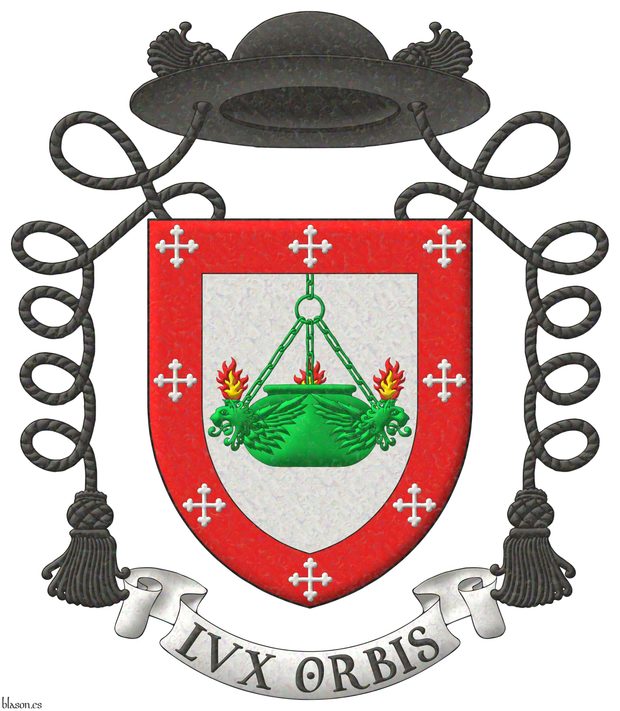
Argent, a suspended oil lamp of three lions' heads erased and winged Vert, two heads visible, enflamed proper; a bordure Gules, charged with eight crosses botonny Argent. Crest: A galero with two cords, one on each side, each with a tassel Sable. Motto «Lux Orbis».
Escudo de plata, pendiente del jefe una lampara de aceite de tres cabezas de león arrancadas y aladas de sinóple; una bordura de gules cargada de ocho cruces botonadas de plata. Timbrado de un galero con cordones y una borla a cada lado de sable. Lema «Lux Orbis»
Coat of arms emblazoned by me, highlighted with lights and shadows, outlined in Sable, with a pointed outer contour and with a iridescent finishing.
Blazon keywords: Argent, Vert, Gules, Sable, One, Three, Two, Eight, Suspended, Oil lamp, Lion, Head, Erased, Winged, Visible, Enflamed, Proper, Bordure, Charged, Cross botonny, Crest, Galero, Cord, Tassel and Motto.
Style keywords: Outlined in sable, Illuminated, Pointed and Iridescent.
Classification: Religious, Interpreted, Boa and Coat of arms.
Bearer: Iacobucci, Peter.


Pius V
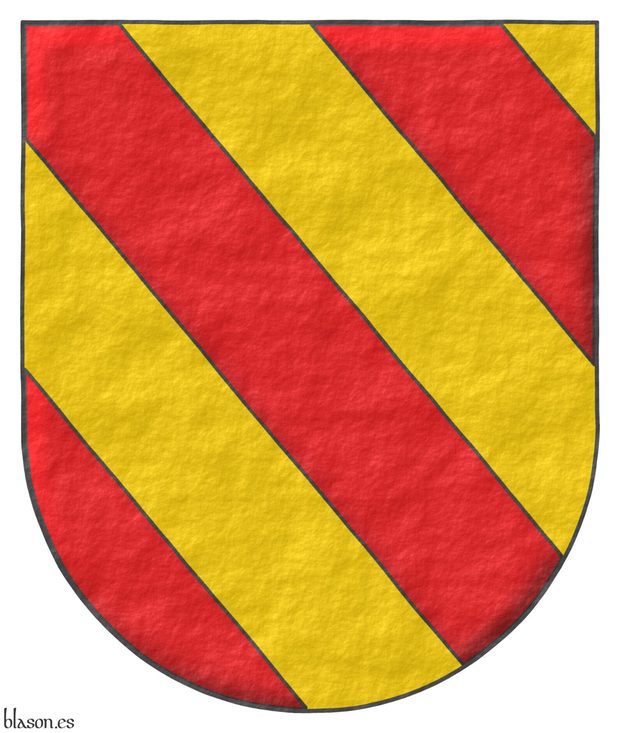
225th Pope of the Church, from 1566 to 1572. «Pius V», named Antonio Michele Ghislieri, was canonized in 1712.
Bendy of six Gules and Or.
Escudo bandado de seis piezas de gules y oro.
Papal coat of arms interpreted with: a rounded mouth; the field in flat tincture of Or; the bands outlined in Sable and illuminated in Gules; and the whole with a rough finish.
I have also seen this coat of arms described as «a shield banded of six pieces of Or and Gules».
Blazon keywords: Without divisions, Bendy, Six, Gules and Or.
Style keywords: Semi-circular, Illuminated, Outlined in sable and Rough.
Classification: Interpreted, Religious and Papal States.
Bearer: Pius V.


Quartered arms of Jacques de Molay
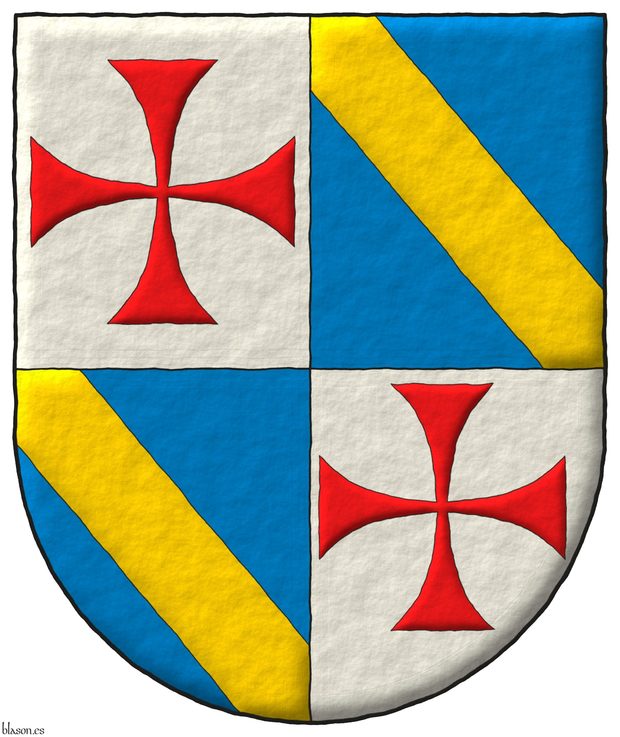
Quarterly: 1 and 4 Argent, a cross patty Gules; 2 and 3 Azure, a bend Or
Escudo cuartelado: 1o y 4o de plata, una cruz patada de gules; 2o y 3o de azur, una banda de oro.
Blazon keywords: Azure, One, Bend, Or, Quarterly, Argent, Cross patty, Cross couped and Gules.
Style keywords: Outlined in sable, Illuminated, Semi-circular and Freehand.
Classification: Religious, Military, Knights Templar, Interpreted and Coat of arms.
Bearer: Molay, Jacques de.


Quartered arms of Renaud de Vichiers
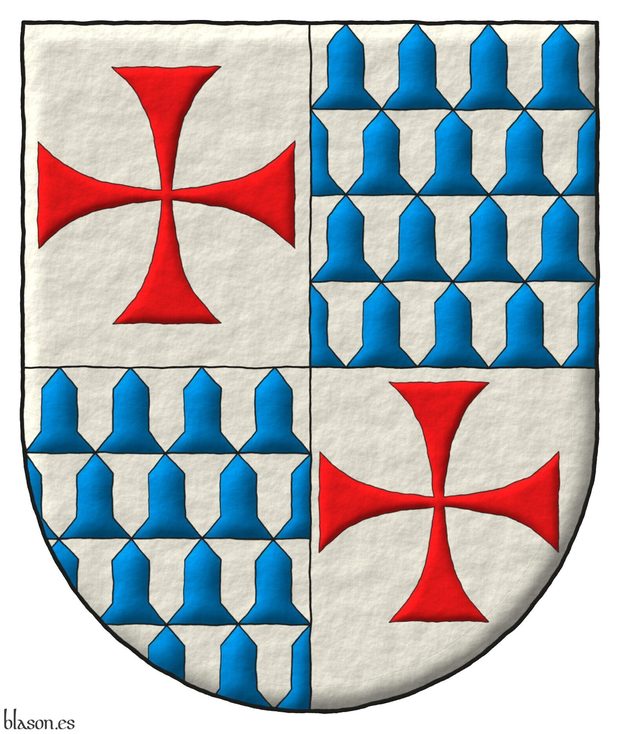
Quarterly: 1 and 4 Argent, a cross patty Gules; 2 and 3 Vair
Escudo cuartelado: 1o y 4o de plata, una cruz patada de gules; 2o y 3o de de veros.
Blazon keywords: Vair, Quarterly, Argent, One, Cross patty, Cross couped and Gules.
Style keywords: Outlined in sable, Illuminated, Semi-circular and Freehand.
Classification: Religious, Military, Knights Templar, Interpreted and Coat of arms.
Bearer: Vichiers, Renaud de.


![Ver [Religious heraldry] en criterios utilizados. Unicornio saltante sobre la divisa, criterio.](../css/Unicornio.Criterio.png)
Religious heraldry
Within religious heraldry, I classify the arms of individuals, offices, dignitaries, institutions, communities, orders, and religious entities, primarily, by tradition, those of the Church.
The arms of the Order of Mercy and those of the Oratorio de San Felipe Neri are examples of religious heraldry.
Being more general, this category encompasses what [Cadenas y Vicent, V. de; 1975; page 59] refers to as «ecclesiastical heraldry».
Categories: Criterion and Religious.


Reverend Nilda Ernestina Lucca de Anaya
Azure, a chevron Or, between in chief a cross potent cantoned of crosslets, and a lion rampant, and in base a Celtic Trinity knot Argent. Crest: A galero Sable, with two cords, each with one tassel Gules and Sable.
Credits:
- Ernesto Juan Anaya is the designer of the coat of arms.
- Antonio Salmerón y Cabañas is the author of the heraldic art.
Blazon keywords: Azure, One, Chevron, Or, Between, In chief, Cross of Jerusalem, Cross couped, Cross potent, Cantoned, Four, Crosslet, Lion, Rampant, In base, Celtic Trinity knot, Knot, Celtic, Trinity, Crest and mantling, Galero, Cord and Tassel.
Style keywords: Outlined in sable, Illuminated, Pointed and Freehand.
Classification: Religious, Interpreted and Coat of arms.
Bearer: Lucca de Anaya, Nilda Ernestina.


Richard de Bures tricking, hatching and plain tincture
Or, six annulets Gules, 3, 2, and 1.
Blazon keywords: Or, Six, Annulet, Gules, Ordered, Three, Two and One.
Style keywords: Outlined in sable, Semi-circular, Tricking, Hatching and Plain tincture.
Classification: Religious, Military, Knights Templar, Interpreted, Coat of arms and Schema.
Bearer: Richard, Richard.


Robert de Craon
Lozengy Or and Gules. Behind the shield a cross patty Gules.
Blazon keywords: Lozengy, Or, Gules, Behind the shield, One, Cross patty and Cross couped.
Style keywords: Outlined in sable, Illuminated, Semi-circular and Freehand.
Classification: Religious, Military, Knights Templar, Interpreted and Coat of arms.
Bearer: Craon, Robert de.


![Ver [Society of Heraldic Arts in Twelve Lineages] en enlaces recomendados. Áncora de oro y la divisa enlace.](../css/Ancora.Enlace.png)
Society of Heraldic Arts in Twelve Lineages
Publication of my admission to the Society of Heraldic Arts, on the blog Twelve Lineages of Soria in an article entitled: The heraldic artist Dr. Antonio Salmerón Cabañas SHA, is appointed member of The Society of Heraldic Arts. Alongside my photograph are shown examples of gentilic, political, and religious coats of arms.
Categories: Link, Personal, Civic and Religious.
Root: Twelve Lineages of Soria.


Tremelay, Bernard de
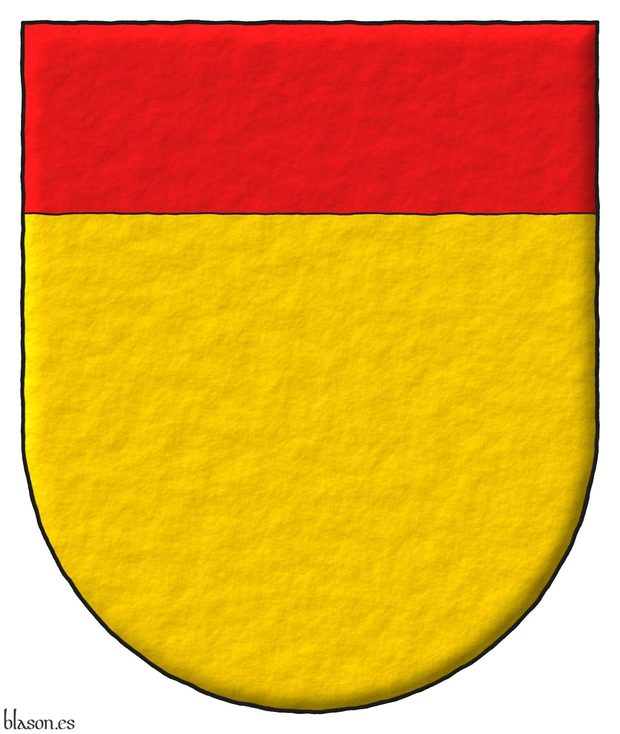
Or, a chief Gules.
Escudo de oro, un jefe de gules.
Coat of arms emblazoned by me with a semi-circular shape, illuminated, and with a freehand finishing.
Blazon keywords: Or, Chief and Gules.
Style keywords: Outlined in sable, Semi-circular, Illuminated and Freehand.
Classification: Religious, Military, Knights Templar, Interpreted and Coat of arms.
Bearer: Tremelay, Bernard de.


Urban IV
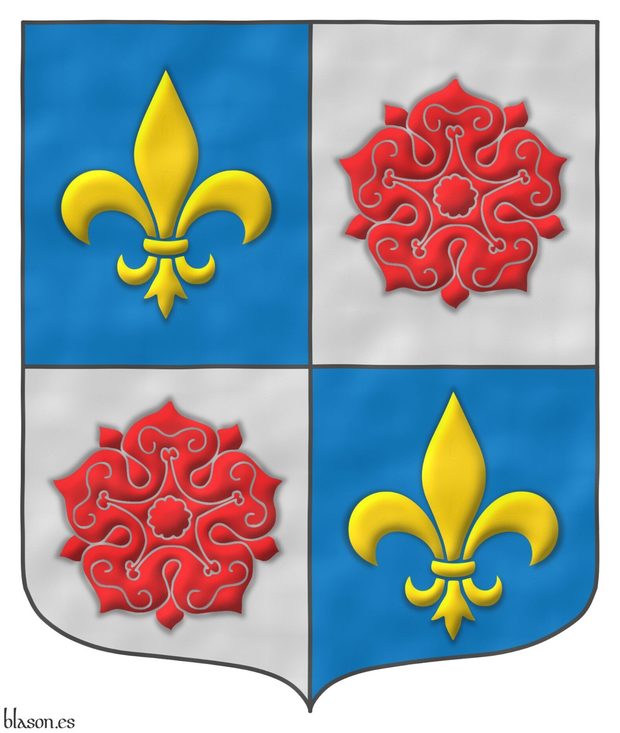
182nd Pope of the Church, from 1261 to 1264. «Urbanus IV», born Jacques Pantaleon of Court-Palais, was born in Troyes, France.
Quarterly: 1 and 4 Azure, a fleur de lis Or; 2 and 3 Argent, a rose Gules.
Escudo cuartelado: 1o y 4o de azur, una flor de lis de oro; 2o y 3o de plata, una rosa de gules.
Coat of arms of Urban IV with: a pointed and rounded shield shape; the field in plain Azure and Argent enamels; the figures outlined in the field, shaded and illuminated in Or and Gules; and with a watercolor finish.
Blazon keywords: Quarterly, Azure, One, Fleur de lis, Or, Argent, Rose and Gules.
Style keywords: Ogee, Illuminated, Shaded, Outlined in the field tincture and Watercolor.
Classification: Interpreted, Religious and Papal States.
Bearer: Urban IV.


Urban V
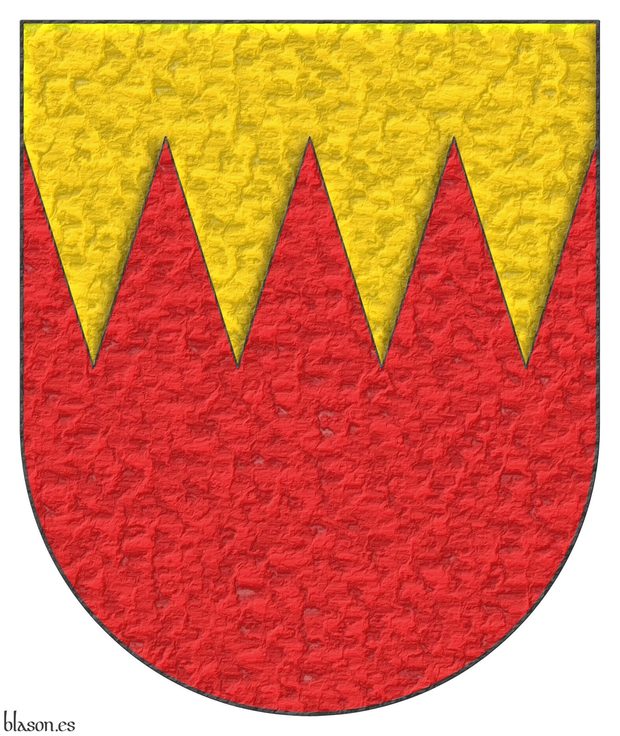
200th Pope of the Church, from 1362 to 1370. «Urbanus V», born Guillaume de Grimoard, was born in Le Pont-de-Montvert, in the Languedoc.
Gules, a chief dancetty of four full points Or.
Escudo de gules, un jefe encajado de cuatro piezas enteras de oro.
Papal coat of arms interpreted with: a round-topped shield; the field in plain Gules; the chief indented, illuminated in metal Or, and outlined in Sable; and the whole design in hammered metal.
[Rietstap, J. B.; 1861] blazons it as Grimoard «de gueules, au chef émanché de quatre pièces d'or».
Blazon keywords: Gules, Chief, Dancetty, Or, Three and Two.
Style keywords: Semi-circular, Illuminated, Outlined in sable and Metal beaten.
Classification: Interpreted, Religious and Papal States.
Bearer: Urban V.


Urban VI

202nd Pope of the Church, from 1378 to 1389. «Urbanus VI», named Bartolomeo Prignano, born in Itri, near Naples, in the Lazio region.
Or, an eagle displayed Azure.
Escudo de oro, un águila de azur.
Papal coat of arms interpreted with: a pointed mouth; the field in flat tincture of metal Or; the eagle illuminated in Azure, shaded and outlined in the color of the field; and the whole with a rough finish.
Blazon keywords: Without divisions, Or, One, Eagle and Azure.
Style keywords: Pointed, Illuminated, Outlined in the field tincture, Shaded and Rough.
Classification: Interpreted, Religious and Papal States.
Bearer: Urban VI.
-
Language
-
Categories of heraldry
-
Divisions of the field
- Without divisions
- Party per pale
- Party per fess
- Party per bend
- Party per bend sinister
- Tierce
- Tierce sinister
- Tierced per pale
- Tierced per fess
- Tierced per bend
- Tierced pallwise inverted
- Quarterly
- Quarterly per saltire
- Gyronny
- Party per fess, the chief per pale
- Party per pale, the sinister per fess
- Party per fess, the base per pale
- Party per pale, the dexter per fess
- Chapé
- Chaussé
- Embrassé
- Contre-embrassé
- Party per chevron
- Enté
- Enté en point
- Flanched
-
Metals
-
Colours
-
Furs
-
Other tinctures
-
Ordinaries and sub-ordinaries
-
Diminutives of the ordinaries
-
Geometric charges
-
Composite ordinaries
-
Inanimate charges from Nature
Atom, Crescent, Diamond, Emerald, Estoile, Increscent, Lightning flash, Moon, Mount, Mullet, Mullet of four points, Orbital, Plough of Ursa Major, Rainbow, Ray of the sun, River, Sea, Snowflake, Sun, Sun in splendour, Sun of May, Trimount, Water and Wave.
-
Vegetal charges from Nature
Acorn, Apple, Apple tree, Ash, Bluebonnet, Camellia, Chrysanthemum, Cinquefoil, Cornflower, Dogwood flower, Double rose, Elm, Fleur de lis, Flower, Gourd, Holm oak, Hop cone, Kapok tree, Laurel, Lily, Linden, Lotus flower, Madonna lily, Mexican cedar tree, Oak, Olive tree, Palm tree, Plantain plant, Pomegranate, Poplar leaf, Rose, Shamrock, Sunflower, Thistle, Tree, Tulip, Vine and Wheat.
-
Animal charges from Nature
Badger, Bald eagle, Barbel, Barn owl, Bear, Beaver, Beetle, Bighorn sheep, Blackbird, Boar, Brach hound, Bull, Doe, Dog, Dolphin, Dove, Eagle, Elephant, Falcon, Female figure, Fish, Flame, Fly, Fox, Frog, Goat, Goldfinch, Goose, Heron, Horse, Hummingbird, Jaguar, Lark, Leopard, Lion, Lion passant, Lion rampant guardant, Lioness, Lynx, Male figure, Martlet, Merino ram, Owl, Panther, Parrot, Peacock, Pelican, Pelican in her piety, Puffin, Quetzal, Raven, Roe deer, Rooster, Savage, Seagull, Serpent, She-wolf, Stag, Starling, Talbot, Tyger, Vulture, Warren hound and Wolf.
-
Parts of natural charges
Arm, Beak, Branch, Caboshed, Chest, Claw, Covert, Dorsal fin, Eagle claw, Ermine spot, Escallop, Feather, Foot (palmiped), Foreleg, Forepaw, Hand, Head, Heart, Hoof, Leaf, Neck, Ostrich feather, Palm frond, Paw, Roe deers' attires, Shoulder, Sprig, Stags' attires, Stem, Swallow-tail, Tail, Tail addorsed, Tail fin, Talon, Tooth, Trunk, Trunk (elephant), Two hands clasped, Two wings in vol, Udder, Wheat spike, Wing and Wrist.
-
Artificial charges
Ace of spades, Anchor, Anvil, Arch, Arm vambraced, Armillary sphere, Arrow, Axe, Bell, Bell tower, Beret, Bonfire, Book, Bookmark, Bow, Branding iron, Bridge, Broken, Buckle, Cannon, Cannon dismounted, Cannon port, Canopy roof, Carbuncle, Castle, Celtic Trinity knot, Chain, Chess rooks, Church, Clarion, Clay pot, Closed book, Club, Column, Comb, Compass rose, Conductor's baton, Cord, Covered cup, Crozier, Crucible, Cuffed, Cup, Cyclamor, Dagger, Double vajra, Drum, Ecclesiastical cap, Fanon, Federschwert, Fleam, Four crescents joined millsailwise, Galician granary, Garb, Gauntlet, Geometric solid, Grenade, Halberd, Hammer, Harp, Host, Hourglass, Key, Key ward, Knight, Knot, Lantern, Letter, Line, Loincloth, Menorah, Millrind, Millstone, Millwheel, Monstrance, Mortar, Mullet of six points pierced, Nail, Non-classic artifact, Norman ship, Number, Oar, Oil lamp, Open book, Page, Pair of scales, Parchment, Pestle, Piano, Pilgrim's staff, Plough share, Polish winged hussar, Port, Portcullis, Potent, Quill, Ribbon, Rosette of acanthus leaves, Sabre, Sackbut, Sail, Scroll, Scythe, Sheaf of tobacco, Ship, Skirt, Spear, Spear's head, Stairway, Star of David, Step, Sword, Symbol, Tetrahedron, Torch, Tower, Trident, Trumpet, Turret, Two-handed sword, Wagon-wheel, Water-bouget, Wheel, Winnowing fan and With a turret.
-
Immaterial charges
Angel, Archangel, Basilisk, Dragon, Dragon's head, Garuda, Golden fleece, Griffin, Heart enflamed, Justice, Mermaid, Our Lady of Mercy, Ouroboros, Paschal lamb, Pegasus, Phoenix, Sacred Heart of Jesus, Saint George, Sea-griffin, Trinity, Triton, Unicorn, Winged hand and Wyvern.
-
External elements
-
Heraldic creations
-
References
-
Formats
-
Keywords on this page
Between, Watercolor, Proper, Winged, Pointed, Article, Azure, Bend, Bendy, Boa, Bordure, Tassel, Charged, Ogee, Heart, Cord, Created, Cross, Cross patty, Cross couped, Quarterly, Four, Outlined in sable, Outlined in the field tincture, Two, Emblem, In chief, In base, Coat of arms, Papal States, Gules, Illuminated, Interpreted, Chief, Semi-circular, Hard metal, Soft metal, Military, Knights Templar, Or, Pale, Argent, Without divisions, Religious, Sable, Six, Freehand, Three and One.

